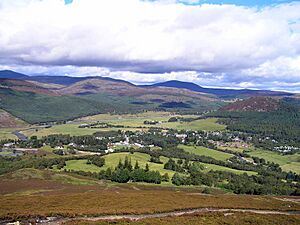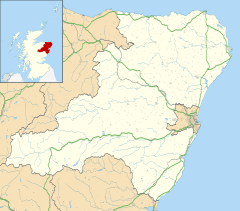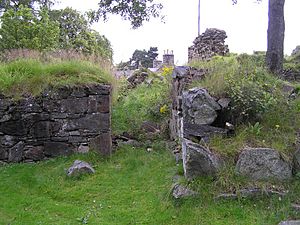Braemar facts for kids
Quick facts for kids Braemar
|
|
|---|---|
| Population | 808 (2011) (Crathie and Braemar Civil Parish) |
| OS grid reference | NO150913 |
| • Edinburgh | 73 mi (117 km) |
| • London | 402 mi (647 km) |
| Council area | |
| Country | Scotland |
| Sovereign state | United Kingdom |
| Post town | BALLATER |
| Postcode district | AB35 |
| Dialling code | 013397 |
| Police | Grampian |
| Fire | Grampian |
| Ambulance | Scottish |
| EU Parliament | Scotland |
| UK Parliament |
|
| Scottish Parliament |
|
Braemar is a small village in Aberdeenshire, Scotland. It is about 58 miles (93 km) west of Aberdeen in the beautiful Scottish Highlands. Braemar is the closest big village to the start of the River Dee. It sits high up, at about 339 meters (1,112 feet) above sea level.
The Scottish Gaelic name for the area is Bràigh Mhàrr, which means "upper Marr." This refers to the higher parts of Marr, west of Aboyne. The village itself used to be called Castleton of Braemar, or Baile a' Chaisteil in Gaelic. Long ago, the village was also known as Cinn Drochaid, meaning "bridge end."
Contents
Exploring Braemar: Geography and Climate
Braemar is easy to reach by road, especially on the A93 from the south through Glen Clunie and the Cairnwell Pass, or from the east along Deeside. You can also hike to Braemar from the west through several glens like Glen Tilt and Glen Feshie. It's about a one-and-a-half-hour drive from cities like Aberdeen, Dundee, and Perth.
The village is surrounded by hills. To the northwest is Carn na Drochaide (818 m), to the northeast is Creag Choinneach (538 m), and to the southwest is Morrone (859 m).
Braemar's Weather

Braemar has a cool climate, similar to many parts of the United Kingdom. However, it's often colder than other places in Scotland because it's high up. It's one of the coldest low-lying places in the UK.
Braemar holds a record for being one of the coldest spots in the UK. On two occasions, February 11, 1895, and January 10, 1982, the temperature dropped to a very chilly -27.2°C (-17°F). This record is shared with Altnaharra in the Scottish Highlands.
The village usually has about 102 days of frost each year. It also gets rain on about 153 days. Snowfall can be quite heavy in winter and early spring. It often piles up to 30 cm (12 inches) or more. On February 9, 2021, one weather watcher even recorded 70 cm (28 inches) of snow!
Braemar can also have big changes in temperature in a single day. For example, on September 30, 2015, it had one of the biggest temperature swings in the UK. It was 24.0°C (75.2°F) during the day and then dropped to -1.3°C (29.7°F) at night. The next day, it set a new October record for Braemar, reaching 22.7°C (72.9°F).
| Climate data for Braemar WMO ID: 99089; coordinates 57°00′38″N 3°23′50″W / 57.01069°N 3.39727°W; elevation: 339 m (1,112 ft); 1991–2020 normals, extremes 1880–present |
|||||||||||||
|---|---|---|---|---|---|---|---|---|---|---|---|---|---|
| Month | Jan | Feb | Mar | Apr | May | Jun | Jul | Aug | Sep | Oct | Nov | Dec | Year |
| Record high °C (°F) | 16.6 (61.9) |
16.1 (61.0) |
22.0 (71.6) |
24.5 (76.1) |
27.2 (81.0) |
30.0 (86.0) |
30.0 (86.0) |
30.0 (86.0) |
26.7 (80.1) |
23.8 (74.8) |
17.7 (63.9) |
14.1 (57.4) |
30.0 (86.0) |
| Mean daily maximum °C (°F) | 4.8 (40.6) |
5.2 (41.4) |
7.3 (45.1) |
10.2 (50.4) |
13.8 (56.8) |
16.2 (61.2) |
18.2 (64.8) |
17.4 (63.3) |
15.0 (59.0) |
10.9 (51.6) |
7.4 (45.3) |
5.0 (41.0) |
11.0 (51.8) |
| Daily mean °C (°F) | 1.9 (35.4) |
2.1 (35.8) |
3.6 (38.5) |
5.9 (42.6) |
8.9 (48.0) |
11.8 (53.2) |
13.6 (56.5) |
13.0 (55.4) |
10.7 (51.3) |
7.5 (45.5) |
4.3 (39.7) |
2.0 (35.6) |
7.1 (44.8) |
| Mean daily minimum °C (°F) | −1.1 (30.0) |
−1.1 (30.0) |
−0.1 (31.8) |
1.5 (34.7) |
3.9 (39.0) |
7.3 (45.1) |
9.0 (48.2) |
8.6 (47.5) |
6.5 (43.7) |
4.1 (39.4) |
1.2 (34.2) |
−1.1 (30.0) |
3.3 (37.9) |
| Record low °C (°F) | −27.2 (−17.0) |
−27.2 (−17.0) |
−21.7 (−7.1) |
−13.3 (8.1) |
−8.9 (16.0) |
−3.3 (26.1) |
−1.7 (28.9) |
−2.4 (27.7) |
−6.1 (21.0) |
−11.4 (11.5) |
−23.3 (−9.9) |
−25.8 (−14.4) |
−27.2 (−17.0) |
| Average precipitation mm (inches) | 100.9 (3.97) |
74.9 (2.95) |
66.4 (2.61) |
57.6 (2.27) |
59.2 (2.33) |
58.9 (2.32) |
70.3 (2.77) |
74.4 (2.93) |
68.9 (2.71) |
109.1 (4.30) |
101.0 (3.98) |
98.0 (3.86) |
939.4 (36.98) |
| Average precipitation days (≥ 1.0mm) | 14.3 | 13.3 | 13.2 | 11.0 | 11.8 | 11.8 | 12.4 | 11.8 | 11.4 | 15.3 | 15.6 | 15.0 | 156.8 |
| Mean monthly sunshine hours | 29.0 | 58.2 | 104.2 | 142.6 | 186.4 | 157.0 | 157.0 | 144.3 | 115.9 | 66.6 | 38.8 | 22.1 | 1,221.8 |
| Source 1: Met Office | |||||||||||||
| Source 2: KNMI | |||||||||||||
Braemar's Past: A Look at History
Braemar is built around the Clunie Water, a river that was important for crossing. This area was part of an old pathway called the Elsick Mounth. Both the ancient Picts and the Romans used this route. The village is in the upper part of the old Earldom of Mar, which is why it's called the "Braes o' Mar" (meaning "hills of Mar").
Long ago, before the 11th century, there were two separate small villages. One was Auchendryne on the west side of the Clunie Water, and the other was Castleton (or Bail Chasteil) on the east side. The name 'Castleton' comes from Kindrochit Castle, which is inside the modern village. 'Kindrochit' means "bridge end."
Legend says that King Malcolm III came to this area around 1059. He built a wooden bridge connecting the two sides of the river. The castle was likely built to protect this important crossing. The ruins you see today are mostly from the 14th century. They replaced the original wooden castle.
In 1715, a Scottish nobleman named the Earl of Mar started a rebellion called the 1715 Jacobite Rising right here in Braemar. This was an attempt to bring the old royal family back to the throne.
For a long time, Braemar was mostly owned by two big estates: Mar Lodge Estate and Invercauld. Each estate even had its own pub! The Fife Arms Hotel was in Auchendryne, and the Invercauld Arms Hotel was in Castleton. The Invercauld Arms was built over the spot where the Earl of Mar started the Jacobite rebellion.
The Catholic Church in Braemar, dedicated to Saint Andrew, was built in 1839. Another church, St Ninian's Chapel, Braemar, was finished in 1898.
A famous Scottish-German scientist named Johann von Lamont (1805–1879) was born near Braemar. He was a pioneer in studying the Earth's magnetic field.
Language in Braemar
In 1891, a lot of people in Braemar, about 59.2%, spoke Gaelic every day. In a smaller nearby village called Inverey, even more people, 86.3%, spoke Gaelic. The Gaelic spoken in this part of Scotland was similar to the Gaelic spoken in other nearby areas. Sadly, the last person who spoke the local Braemar Gaelic dialect as their first language passed away in 1984.
By the 2001 census, only a very small number of people (5 out of 839) in the Braemar area said they could speak Gaelic.
The Braemar Gathering: A Royal Tradition
The Braemar Gathering is a famous annual event, often called "The Games." It's a type of Highland games and is believed to have started with events held by King Malcolm III long ago. Today, it takes place on the first Saturday of September. The British royal family traditionally attends this special event.
After a law in 1746 stopped all clan gatherings, people were excited when they could hold them again in 1782. The Braemar Highland Society was formed in 1815. The first modern games with cash prizes happened in 1832.
A very important moment was on September 14, 1848, when Queen Victoria attended the Gathering. In 1866, the society was allowed to add "Royal" to its name, becoming the Braemar Royal Highland Society. In 1906, the Duke of Fife gave 12 acres (4.9 hectares) of land to the society. This land became the Princess Royal and Duke of Fife Memorial Park, where the Braemar Gathering is held today.
Since Queen Victoria's time, the ruling monarch has been the patron of the Braemar Royal Highland Society. The monarch is also known as the Chieftain at the games. Today, King Charles III is the Chieftain of the Braemar Gathering.
Many exciting events happen at the Gathering, including:
- hill running (running up and down hills);
- heavy events (like throwing the hammer or tossing the caber);
- light events (like track and field sports); and
- Highland dancing. The dancing is very high quality because the organizers choose the best dancers. The dancing stage is right in front of the royal family's seating area, so dancers are often watched by members of the royal family, including Queen Elizabeth II and King Charles III.
Another fun event at Braemar is the presentation of awards for the Aberdeenshire League/Walker's Shortbread League. The top six dancers from different Highland games held over the summer get their awards here. Each dancer receives a tin of Walker's shortbread (which is why it's nicknamed the 'Shortbread League') and a special prize like a vase or picture.
Things to Do in Braemar: Amenities
Braemar has a golf course where you can play. There are two large hotels, the Fife Arms and the Invercauld Arms. You can also find many smaller hotels and places that offer bed and breakfast rooms. There's a big youth hostel and a caravan site for campers.
The village also has a small post office and a shop. You can even rent mountain bikes to explore the area!
The Morrone Birkwood Nature Reserve is a beautiful nature reserve right on the edge of the village. It's a great place to explore nature.
Getting Around: Transportation
There is a regular bus service that connects Braemar to Aberdeen.
Famous People from Braemar
- John Farquharson (1699-1782) was born near Braemar. He became a Roman Catholic priest and was known for collecting old Scottish Gaelic stories and songs. These stories later became important in discussions about the famous "Ossian" poems.
See also
 In Spanish: Braemar para niños
In Spanish: Braemar para niños







